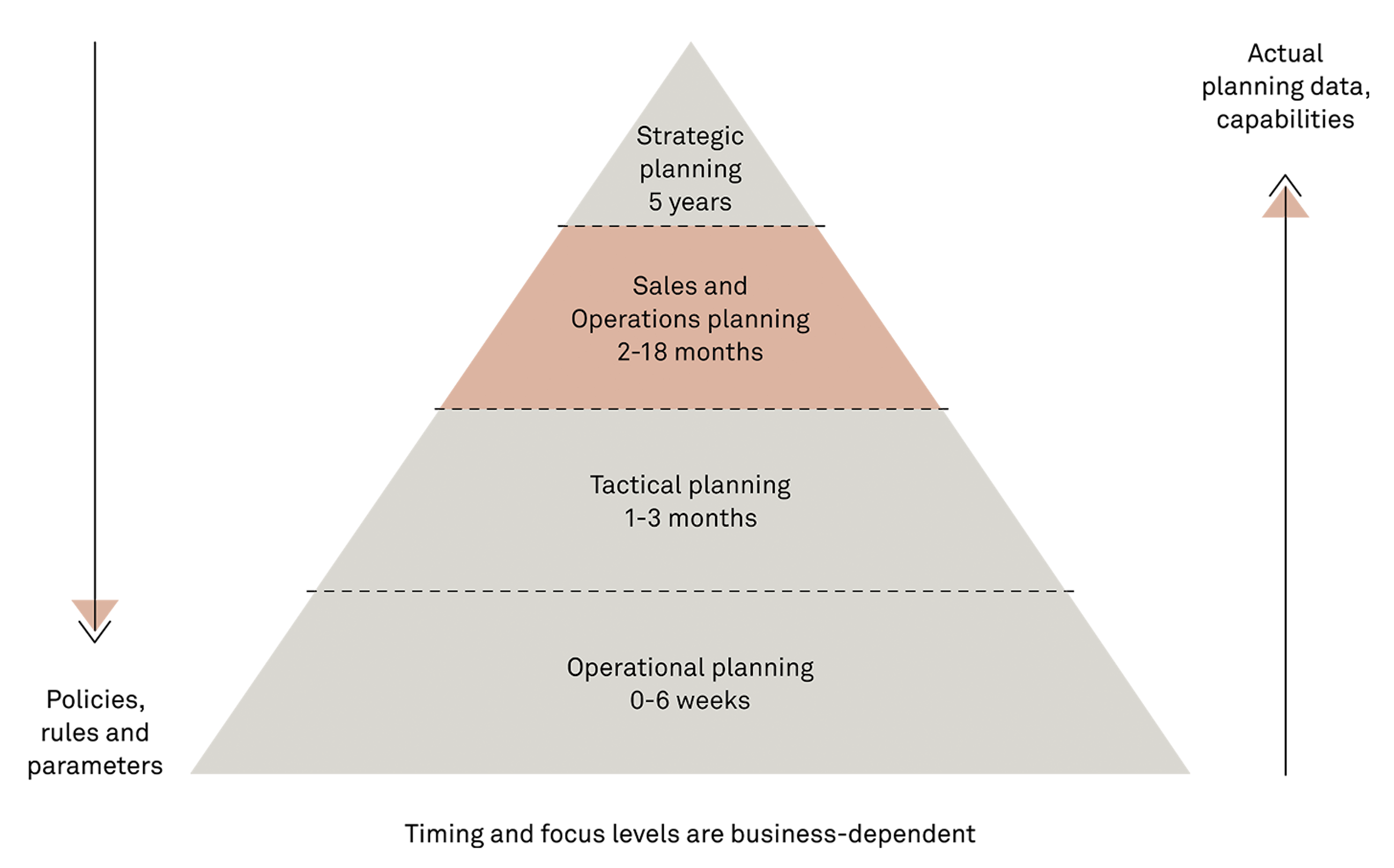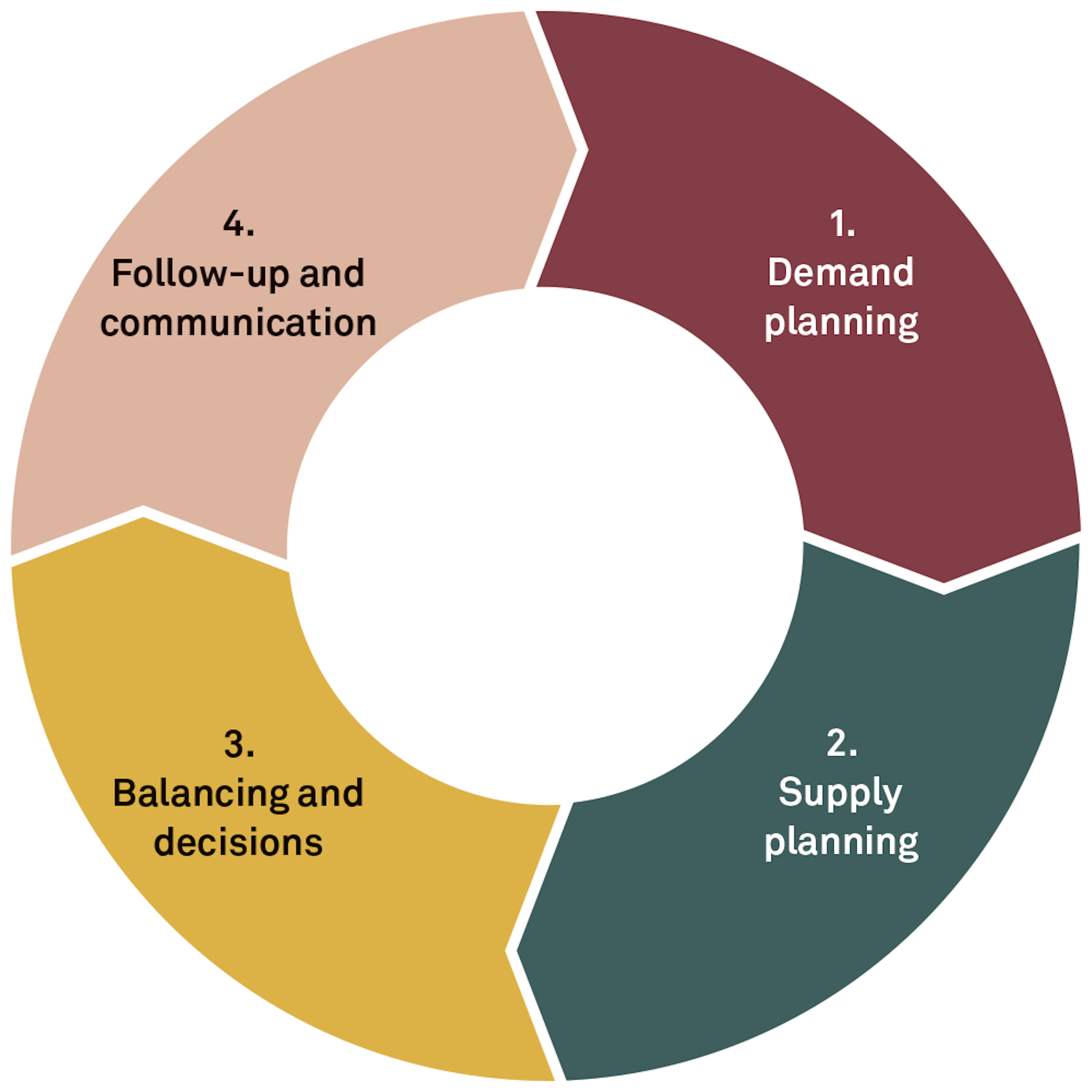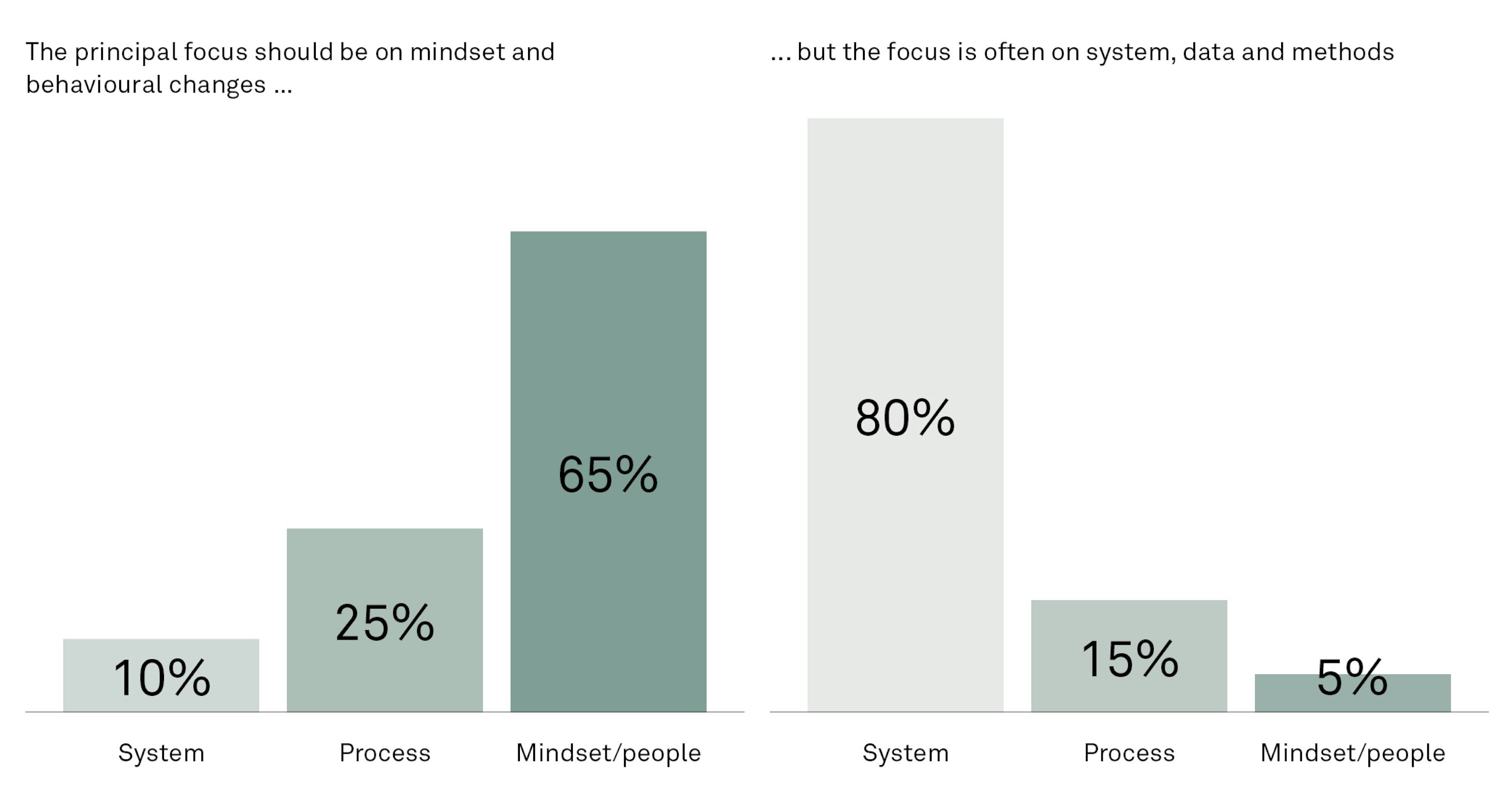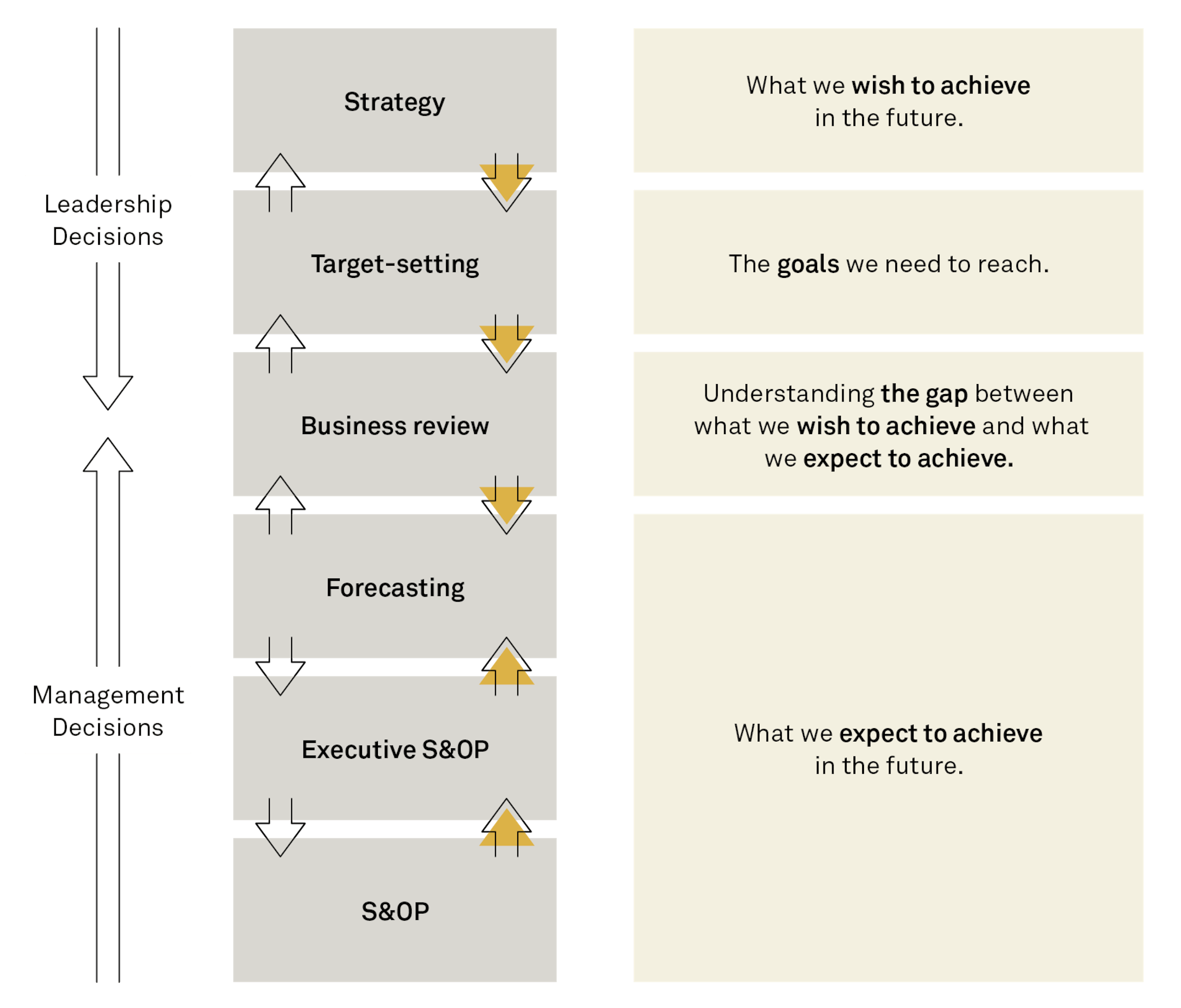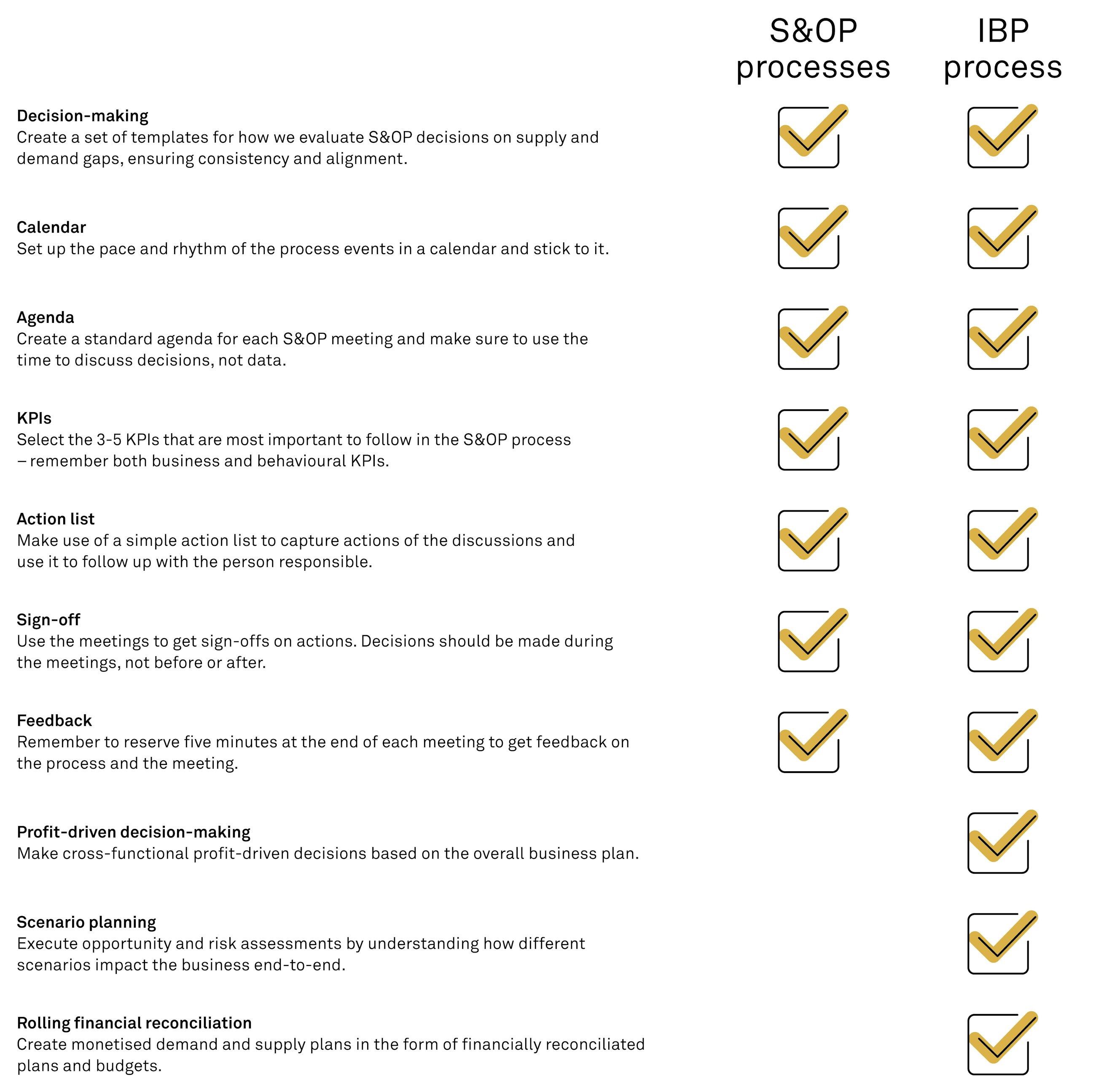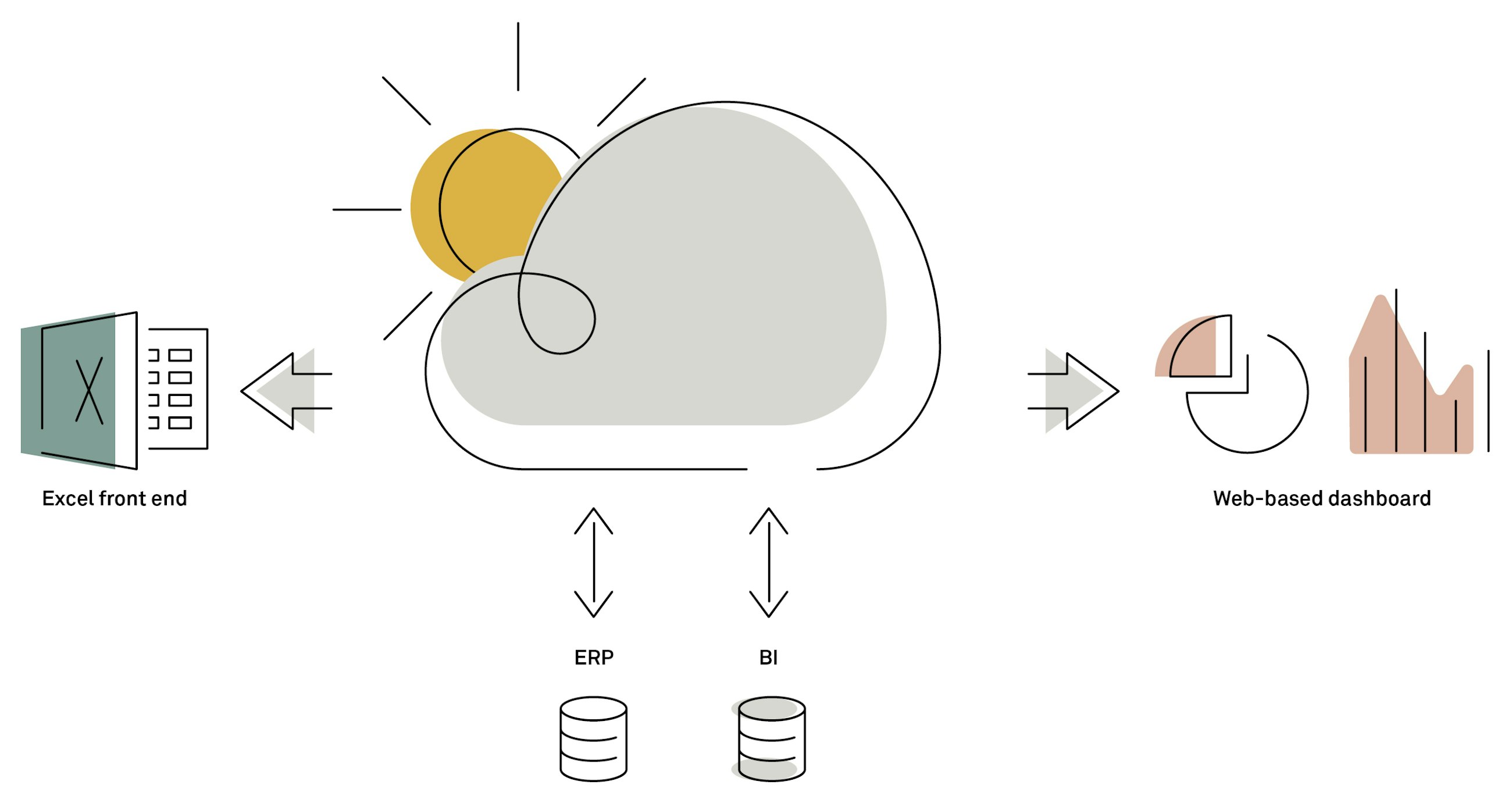Integrated Business Planning
14 October 2019
What is Integrated Business Planning – and how does it differ from Sales & Operations Planning?
Sales and Operations Planning (S&OP) is a cross-functional decision-making process that you can use to steer your organisation to better balance demand and supply. With S&OP, you bring the functions in the organisation together, and help them speak the same language and have the same plan. Also, you can use S&OP to help bridge the gap between long-term strategic plans and short-term operational plans.
Integrated Business Planning (IBP) builds on the S&OP process, and by including finance to a higher extent it enhances the S&OP framework to:
- Make timely decisions that are driven by company profitability rather than silo targets
- Base decisions on clearly mapped fact-based scenarios rather than gut feelings
- Integrate the rolling business plan with the financial budget on a continuous basis
By doing S&OP/IBP, you will continually achieve focus, alignment and synchronisation among all functions of the organisation.
The difference lies in the maturity…
Wallace and Stahl originally defined S&OP as:
“S&OP is a set of decision-making processes to balance demand and supply, to integrate financial planning and operational planning and to link high-level strategic plans with day-to day operations”.
If you compare this definition with the definition of IBP, you see that there is very little difference.
However, as S&OP has matured there now seems to be an agreement amongst practitioners that S&OP is most relevant for the first three maturity levels, while the value of IBP comes into its own in the last two, in terms of scope and involvement.
To us, IBP is a more advanced version of the S&OP process, using S&OP as a foundation. In IBP, tools and systems are usually more integrated and automated than in S&OP. The core process and the people side has the same origin for both.
So, why should you care about IBP?
There are a lot of reasons why you should care about Integrated Business Planning.
IBP helps you to:
- Establish a framework for decision-making
- Link operations, sales and finance processes by speaking the same language
- Drive decisions towards profit maximisation and so that they support the company strategy
- Agree on a clear set of roles and responsibilities across functions
- Create transparency across your entire organisation
Our take on Integrated Business Planning
Integrated Business Planning is about doing what is best for the company and therefore the overall purpose of the IBP process is to establish one overall plan for the company.
The S&OP/IBP process has an aggregated focus on, e.g. product group level, customer group and capacity group level, that enables policies, rules and parameters to be communicated to the tactical and operational planning processes.
Targets and policies are supplied downwards, while capabilities and actual performance are sent up:
When we work with our S&OP/IBP process, it must therefore have a long-term focus that is aligned with the other planning processes in our planning hierarchy.
We describe S&OP/IBP in four core steps:
1. Demand planning:
Covers the process of creating and validating an unconstrained demand signal (Sales Forecast) 18-24 months ahead. It includes input from relevant participants from the commercial side.
After the sign-off, the forecast feeds two recipients: Supply to plan capacities and Finance to support financial planning and forecasting.
2. Supply planning:
The unconstrained demand signal is translated into a demand plan per factory, including “inter-company” requirements.
The supply situation (i.e. raw materials, capacity, inventory) is reviewed and gaps are identified. Options to synchronise the supply chain are identified and discussed.
3. Balancing and decisions:
All local plans are consolidated to get a global overview. Different what-if scenarios are analysed to support the overall risk assessment of the plan.
Based on the scenario evaluation, decisions are made and recommendations are presented to executive members.
4. Follow-up and communication:
Once the decisions have been made and final adjustments have been made to overall plan, the final committed plan is communicated and executed. This also includes a follow-up on decision-making and KPIs.
A well-established S&OP/IBP process is characterised by:
- A single consensus demand plan
- Look-out over a period of +18 months
- Cross-functional participation in S&OP – including finance
- A senior leadership-owned process
- Formal targets with accountability in place
- The proper discipline in the organisation to adhere to S&OP decisions – people execute according to what is decided
- The ability to reconcile demand and supply plans and identify gaps and imbalances
- The ability to conduct what-if modelling supporting S&OP decisions
The human factor of IBP/S&OP
People, people, people
In any implementation, the impact you achieve is highly dependent on whether you succeed in encouraging people to work according to the new processes and with the desired behaviour. And implementing S&OP/IBP is no exception.
You can only achieve the full potential of S&OP/IBP if you remember that it is essential to invest time and focus on the human side: in people!
Stakeholder management is key
People are an essential part of successful S&OP/IBP. Many stakeholders are involved in the S&OP/IBP process, as it covers many different areas of the business.
Different stakeholders will inevitably bring different mindsets and objectives to the table, and one of the biggest challenges you will meet in any type of S&OP/IBP implementation is how you handle all of the many different stakeholders. Here, stakeholder management is a crucial competence.
To be successful in S&OP/IBP, you must therefore build the right competencies within both change management and stakeholder management. Hereby, you can unlock the latent potential faster and with greater impact.
Understanding human nature
We believe it’s important to invest equal time in building the following three competencies to achieve successful S&OP/IBP implementation:
Regarding S&OP/IBP, we can break down the understanding of human nature into seven topics, where you should spend most time:
- Ensuring involvement across the entire business value chain through interviews, workshops and feedback
- Making sure that roles are clarified, possibly through gamification
- Setting the right strategic goals of S&OP/IBP – creating a clear impact case that is linked to the company strategy
- Resolving KPI conflicts
- Having top-down managers as role models in the process (live S&OP/IBP)
- Facilitating communities for knowledge sharing and career building
- Training in stakeholder management: motivation, communication, relations and trust and human reactions
Do you need stakeholder management coaching?
We have a training concept called “Stakeholder management in S&OP/IBP” which builds upon proven methods from project management, change management, leadership development and personal development.
We created the training framework to meet the needs we saw for different roles to work together in the everyday S&OP process (and related planning processes). In the framework, we therefore focus more on “running the business” than on “changing the business” – even through there are many similarities.
We apply the training framework in S&OP projects/after projects, in S&OP training and at S&OP conferences. The training framework contains tools in four main areas:
Want to know more? 0 1
Cases
Strategy to drive decision-making
IBP will enable the organisation to work effectively with the integration in their performance management model and allow for the strategic decision-making to be pushed downwards in the organisation. During the S&OP meetings, decisions can be made on profitability, markets, channels etc. that fit with the strategic direction and defined targets due to improved transparency of data and the simulation of various scenarios.
The performance management model will consist of top-down and bottom-up activities. Business review meetings will be held to review and discuss the gaps between actual performance and the defined targets. Actions are then identified to close those gaps.
Moving towards dynamic planning
The periodic review and update of the S&OP will provide valuable input to finance and allow for them to establish a dynamic financial forecast process based on simple assumptions.
Read how Royal Greenland aligned their decision-making and planning process to their strategy.
FMCG Industry
Royal Greenland on their use of Integrated Business Panning.
Process industry
Novozymes on their use of Integrated Business Planning
How to start, where to begin?
It all sounds good and easy, but how do you get started? Where do you begin?
First of all, it is important that you make the effects of the S&OP/IBP initiative and how it will link to the overall strategy clear for the business.
Secondly, when getting started you need to secure sponsorship from decision-makers, as this ensures commitment among key stakeholders.
We propose focusing on four elements when implementing or improving Integrated Business Planning:
These steps can help you get going and ensure that you consider (what we believe to be) core enablers of getting started with S&OP/IBP. But, if you have high ambitions and limited time to deliver changes/impact, you might also benefit from visiting our page about the project methodology “Half Double”.
The IBP maturity assessment 2020
Would you like to know more about S&OP/IBP maturity? Then you can read our maturity assessment and delve into a whole host of insights on IBP maturity.
Dive into the survey results
Our survey includes insights on 50 companies’ IBP maturity across industries.
The assessment started in December 2019 and the first results were published in January 2020.
Let your company's maturity guide you
You must always consider your current maturity when you initiate an S&OP/IBP project.
There is no “one-size-fits-all” approach for S&OP/IBP projects, as each project is shaped individually by the starting point, as well as the definition of specific targets for maturity improvement.
But you can consider a number of generic key elements when you initiate the project.
How do you get started with your S&OP/IBP project?
You can follow this checklist that summarises the key elements of a good S&OP/IBP project. And remember, practice makes perfect.
It is about the journey, not the destination
We often start out with S&OP/IBP as a project. We end the project after the first full cycles are executed and have the ambition of the process being fully implemented in the organisation. However, this rarely holds true.
S&OP/IBP is about people who have to change their behaviour – and it takes time to fully integrate behavioural changes into your organisation. This means that S&OP/IBP is a constant journey, and if it is a good process, every process cycle should provide new knowledge and new ideas for process improvement.
Learn fast through pilots
Often, we tend to chase the perfect process template before starting to work in new ways in our organisations. If we work in this way, implementation and learning come rather late in the project.
Therefore, we recommend that you take an agile approach and test through pilots already early in the project. This allows you to collect feedback early in the process which enables you to improve the process right from the beginning.
Therefore, start with a minimum viable product and improve along the way
Digitalisation
Digitalising your S&OP/IBP process - a game-changer for solid business decisions
It is entirely possible to have a well-functioning S&OP process without having digitalised the decision-making process. But if you want to take your decision-making to the next level, you can do so by digitalising your S&OP process with system support. When you enable process data and use it in one unified data model, you increase transparency for decision-making across departments in your organisation.
If you digitalise your S&OP/IBP process you can create better overviews and key decision parameters which enables you to make better decisions. But do not forget the human aspect – because at the end of the day, it is real people who has to make the decisions.
The digital way forward is to go cloud-based
When you make data-driven decisions, it is essential that you have all relevant information at hand. Most commonly, companies use MS Excel as the tool to collect information and structure knowledge from various functions in the organisation. But it can often be a challenge to combine the information from local Excel sheets and create a unified data model.
One set of data creates deeper insights
We recommend that you use a cloud-based solution, that is accessible across all departments of the global organisation and provides information in real-time in one unified data model. Having only one set of data helps you to create deeper insights.
You can find cloud-based solutions from several providers. SAP provides one of the global digital cloud-based solutions in their platform called SAP IBP.
Example
SAP IBP is a strong platform for Integrated Business Planning
You can use SAP IBP to analyse your data and make solid decisions.
The platform offers a variety of functionality such as:
- One cloud-based data model across Sales, Marketing, Operations, Finance
- Integration of SAP and third party systems
- Analysis and execution of what-if scenarios
- Excel front-end with slice & dice of data for fast analyses
- Dashboards and analytics for process meetings


